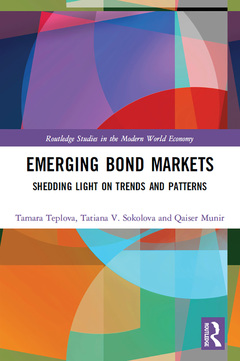Description
Emerging Bond Markets
Shedding Light on Trends and Patterns
Routledge Studies in the Modern World Economy Series
Language: English
Keywords
Corporate Bond Market; Gdp Growth; Financial Securities; Corporate Bonds; ETF; Yield Spread; Emerging Market Bonds; Gdp Growth Rate; Emerging Market Debt; Emerging Bond Markets; Bond Funds; Bond Market; Bond Indices; emerging economies; GARCH Model; well-balanced financial market; OLS Regression; Government Bond Markets; High Yield Bonds; Real Gdp Growth Rate; GARCH; Liquidity Indicators; Emerging Market; CB Spread; VIX Volatility Index; National Bond Market; Non-financial Sector; Key Rate; Stock Index; Domestic Bond Market; GMM Model
Publication date: 04-2022
Support: Print on demand
Publication date: 10-2020
· 15.6x23.4 cm · Hardback
Description
/li>Contents
/li>Readership
/li>Biography
/li>
The bond market is a key securities market and emerging economies present exciting, new investment opportunities. This timely book provides insights into these emerging bond markets through empirical models and analytical databases, i.e. Bloomberg, Eikon Refinitiv and the Russian Cbonds.
The book looks at the dynamics of the development of emerging bond markets, their competitiveness, features and patterns using macro and micro level data. It also takes into consideration various securities type i.e. government, corporate, sub-federal and municipal bonds, to identify respective challenges and risks. The book also analyses factors that may inhibit or stimulate a well-balanced financial market. It includes case studies of Asian, Latin American and Russian bond markets, as also as cross-country comparisons.
It will be a useful reference for anyone who is interested to learn more of the bond market and the modelling techniques for critical data analysis.
Part 1 Trends and determinants of bond market development 1. Change in tendencies in the global debt market: Specifics of development of emerging markets 2. Asian bond markets: Potential benefits for global investors 3. National currency weakness and collective investment as determinants of development of domestic corporate bond markets Part 2 Pricing in bond markets 4. The determinants of government bond yields in emerging markets 5. Regional bond yields: Debt burden and liquidity are the key factors 6. Liquidity metrics in the bond market: Explaining yields in the non-financial and banking sectors 7. Determinants of bank bond spreads in Latin America 8. Specifics of pricing of corporate bonds with embedded put and call options 9. Do covenants really reduce the cost of debt in emerging markets? Part 3 If the default is tomorrow 10. If the default is tomorrow: Factors influencing corporate bond recovery rates 11. Determinants of corporate bond defaults: The role of corporate governance in emerging markets Part 4 Forecasting the dynamics of the bond market 12. Sanction shock and the SSA Caterpillar method: Forecasting the market dynamics 13. Modelling and forecasting systemic risk on the bond market Part 5 ETFs and portfolio investment 14. A new tool for an investor in the bond market: Corporate bond ETF 15. Portfolio investment in emerging bond markets: Trends and determinants Part 6 Anomalies in the bond markets 16. Calendar effects in emerging bond markets 17. Which investment strategy is profitable in the bond market Reverse or momentum? What about risk? Part 7 Analytical and information databases: Algorithms of work 18. Eikon Refinitiv, Bloomberg and Cbonds databases for solving research problems
Tamara Teplova joined HSE (Moscow, Russia) in 1993. HSE is one of the top-300 universities in the world. Dr Teplova is the head of the master program ‘Financial markets and institutions’ and the author of 11 papers in impact factor Scopus journals. She is the head of research projects initiated by government agencies and investment companies.
Tatiana V. Sokolova is a senior lecturer of HSE. Her research interest is financial economics. Dr Sokolova has published some papers in reputable Scopus journals. She is the co-author of two monographs on bond markets (in Rus.). She successfully participated in research projects initiated by the Ministries of the Russian Federation.
Qaiser Munir is a Professor and Director, Center for Business and Economic Research (CBER) at IBA Karachi, Pakistan. He is also a member of Research Studies Evaluation and Review Committee, Ministry of Planning Development and Reform. Prior to joining IBA, he was associated with Universiti Malaysia Sabah (UMS) for ten years as a faculty member.
These books may interest you

Debt Markets and Investments 170.88 €



